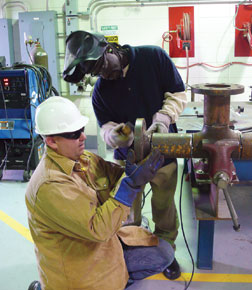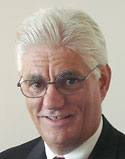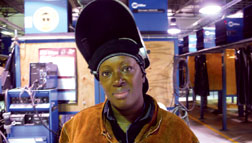 Angelle Bergeron / ENR GREAT instructor in Baton Rouge teaches welding.
|
Tim Horst is neither a juggler nor a matchmaker by trade. Yet the president of Bechtel Group unit Becon Construction Co. and newly named program manager for one of the hurricane-devastated Gulf Coast’s largest construction recruitment programs has had to become a little of both.
Horst is the point person for the Gulf Coast Workforce Development Initiative, an ambitious, business-funded effort launched in 2006 to find and train craft workers to rebuild areas battered by Hurricane Katrina and keep them in place for power, industrial and other major projects planned in the region. Infused with $5 million from the Business Roundtable, the initiative’s “I’m GREAT” pre-apprenticeship program is promising to attract and train 20,000 new industry workers by 2010.
The highly marketed GREAT program stands for “Get Rewarded for Education and Advancement Training.” It is a four-week industry introduction session that Horst says has already turned out 11,078 graduates in Louisiana, Mississippi and Texas who now are ready for advanced craft training or an industry job.
Public-Private Collaboration
The program is a collaboration with industry groups, government agencies and local community and technical colleges. “Neither the private sector nor the government can do it alone,” Horst emphasizes. “If each one trains for its own good, the efforts will be bifurcated and unsuccessful.”
Getting all the partners on track and working effectively to find and train new workers remains a major challenge. While the program touts both union and nonunion participants, organized labor sources say they are less than thrilled that GREAT uses the curriculum of the open-shop National Center for Construction Education and Research, Gainesville, Fla.
 |
| HORST |
“There are a number of labor unions that attend the monthly job fairs and hire graduates from this program,” Horst says. “I am just as happy if they take a union job as if they take a job in the open-shop sector.”
Even so, variations in government support among participating states has impacted graduate and enrollee numbers. Louisiana, which has an additional $20 million in federal and state funding, has trained significantly more recruits than Mississippi, which did not allocate state training grants, Horst says. Alabama and Texas did not even apply for federal grants. Fewer than 300 people have been trained in Texas and none in Alabama to date.
State employment agencies in Louisiana and Mississippi are tracking program graduates to determine how many pursue a career in construction. In Louisiana, about 7,500 of 9,900 program graduates are either working in industry jobs or enrolled in advanced training, according to Autumn Johnson, project coordinator for the Louisiana Community and Technical College System.
“We are just getting into the process of tracking,” says Leon Sellers, recovery assistance project manager for the Mississippi Dept. of Employment Security. He says about two-thirds of GREAT graduates are employed, but some have gone into other industries. “Clearly, we will have to train more than 20,000 to achieve our ultimate goal,” Horst says. “Our intent is 20,000 new people in the industry, not just in training.”
 |
New Choices
About 45 students at the Port Allen, La., campus of Louisiana Technical College are currently enrolled in the GREAT program, says Delano Cline, pathways program coordinator. On a daily basis almost 200 students are being trained at seven college locations, he says. Before the GREAT program began, LTC offered only specialized training per craft.
Not only is GREAT free to enrollees, it also offers a wide choice of craft specialties to those who may have never even considered construction as a career option, Cline says. “In the initial program, they are taught heavy equipment, welding, pipefitting and carpentry,” he says. “It is fast-paced, with classroom and hands-on. We want to draw people into the construction industry and give them skills to get a job. They can improve their skills at night while they’re working.”
|
“Grinding a pipe to have a perfect shine to it, there’s nothing like it. I like it.” — ANGELA THOMAS, ‘GREAT’ WELDING TRAINEE
|
Angela Thomas, formerly a nurse’s assistant, always wanted to go back to school. But she never imagined her education would be in welding. Now she embraces the craft. “It’s interesting,” Thomas says. “It’s so amazing to watch a torch cut through metal. Grinding a pipe to have a perfect shine to it, there’s nothing like it. I like it.”
Master carpenter Gery Frie has been an instructor at the Port Allen campus since the GREAT program began. Originally from British Columbia and union trained, Frie came to the U.S. in 1986 and says the American system of training and certification is haphazard. “It was very hard to find a journeyman carpenter,” he says. “Anyone can get a measuring tape and hammer and call himself a carpenter. When I tried to hire people, very rarely could I find anyone who really had knowledge.”
Defining Standards
GREAT is playing an integral role in defining training standards for what is largely a pool of laborers lacking the skills to progress to the next level, says Frie. “Even if this program peters out, it has helped all other programs in the area by making people aware of the kind of training that is out there,” he points out.
 |
Another element in GREAT’s success is its widespread advertising, Cline says. Initially, the program was marketed heavily in Baton Rouge and Jackson, Miss., cities with large concentrations of hurricane evacuees. “About 60% of our students are people who lost their homes in the New Orleans area with Katrina,” Cline says. “This program gives them opportunities they’ve never had before. It gives them a chance for a better lifestyle, to start a career in a high-demand field.”
The GREAT program originally stood for “Gulf Rebuild: Education Advancement and Training.” But its name was changed earlier this year because students thought enrollment was contingent upon their becoming homebuilders only in Gulf Coast locations, Horst says.
But GREAT has yet to set up a training program in New Orleans because with the slow pace of recovery in the stricken city, there is currently no demand for labor, Horst says. “All the complications with the rebuilding plan, insurance issues and funding for new development there are a variety of reasons why construction has not taken control to move forward in New Orleans,” Horst contends. “If you just train folks and there is no job at the end of the day, the training has been wasted. We need to time the training to support the local demand.”
Timing of GREAT recruitment, training and employment programs, as well as marrying participating groups effectively, has been the biggest challenge for Horst. “When they call in, they want to start class tomorrow, so our marketing must line up with available training,” he says. “You’ve got to get all those pieces together to keep this whole thing moving forward.”
Keeping a watch on Becon’s activities in a booming market also is no small challenge for Horst. But just last month, the firm was named as the 2007 Texas Workforce Employer of the Year for recognizing “the value of resources, services and skills training available through the Texas workforce system,” says state Workforce Commission Chair Diane Rath.

Post a comment to this article
Report Abusive Comment